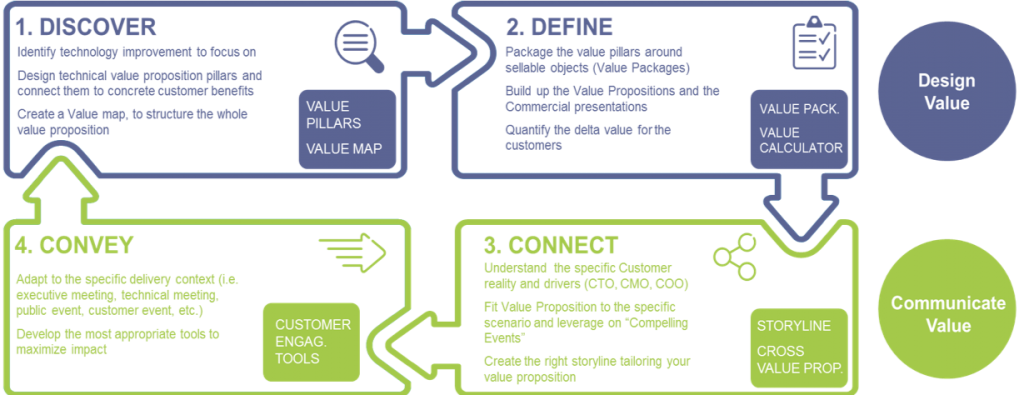What if the value proposition of your products comes out from a structured process with predictable quality, instead of from an improvised and self-made exercise?
A structured approach on Value Creation makes the difference in the product marketing
One of the main challenges for the B2B Companies working on the continuous delivery of new SW products, is the capability to translate lot of small technical enhancements into few worthwhile and tangible customer’s values to be used in the product marketing activities.
This requires a structured approach able to recognize the key value assets to focus on and to communicate them to the market in a smart way able to engage customers on the buy in.
Depending on the context we use to call it “Value Creation” or “Value Development”, addressing the need to have methods and tools to build up a value propositions able to make the difference, inspiring your customers, being easy to be adapted to different contexts and being flexible to follow the changes in the market.
An effective framework for “Value Creation” is based on the cyclic usage of four different steps: Discover and Define related to the phase of Value Design, and Connect and Convey related to the phase of Value Communication. Each phase has specific key deliverables and supporting methods and tools.

Value Design
To translate the product characteristics into a tangible value for your customers you need to select the key technical assets to focus on in your new product and create the “Value Pillars” connected to them. The “Value Pillars” represent the reason of why the customers should perceive a value from your new product, explaining how the new technical assets available in your product can help them to relieve a pain or to address a gain in their daily job.
Connecting the “Value Pillars” to the tangible benefits of your customer, like more savings or new revenues, you create a solid structure for the value of your product, to leverage on in the next steps of the “Value Creation” process. This structure is called “Value Map”, and it represents the foundation of the value creation process.
Starting from a good “Value Map” you can package the value in a way that makes it easier to sell (“Value Packaging”) and you can quantify the “Delta Value” that the new product is able to generate for the customer. The “Value Map” also represents the logical input for the creation of the value proposition.

The main tools used in the “Discover” step are: Value Tree, Driving Forces and CANVAS VPD (Value Proposition Design). The main tools used in the “Define” step are: Value Packaging, Value Calculator, Presentation template.
Value Communication
The proper communication of the value proposition represents a vital step for the final engagement of your customers. One of the key aspects in this phase is the need to select a reasonable and effective subset of “Value pillars” to build up the best message to engage the customer. This activity is also called “Resonating focus”.
Doing that we decide what is more relevant for the customer (considering the priorities of the receivers and the key compelling events) and, at the same time, what is a real “Point of Differentiation” for our value proposition (considering the competitors or the previous offering).

Then, to create a message able to generate interest and inspire the receiver, we can connect together the few selected “Value pillars” around a reasonable and easy to remember “Storyline”.
When the message is ready we have to consider the context where it should be delivered. We could have one hour or ten minutes, we could be in a room or in a big show. Depending on that we design the proper “Engagement tool” to convey the message in the best way, aiming to generate a high impact on the receiver. The “Engagement tools” represent the main deliverables of the Value Creation process.
The main tools used in the “Connect” step are: Resonating Focus, Compelling Events and Storytelling. The main tools used in the “Convey” step are: Dashboards, Flash & Video, Presentation images, Communication campaigns.
Key contributors
The key contributors for marketing activities about your product represent an ecosystem that is vital to know and handle carefully to secure the proper alignment around the key messages and value pillars.
In the Value Design phase are typically relevant the Product Strategy department (to identify the driving forces and the key customer priorities in terms of job to be done and gains & pains) and the R&D (to deep dive on technical value and understand the pillars to focus on). In the Value Communication phase are typically relevant the Sales Development & Key account organizations (to understand the key compelling events in the specific customer reality) and the Marketing departments (to create high impact tools and communication campaigns).

转:A structured approach in translating products into values: REAL CASE SCENARIO
https://blog.tolpagorni.com/a-structured-approach-in-translating-products-into-values-real-case-scenario
